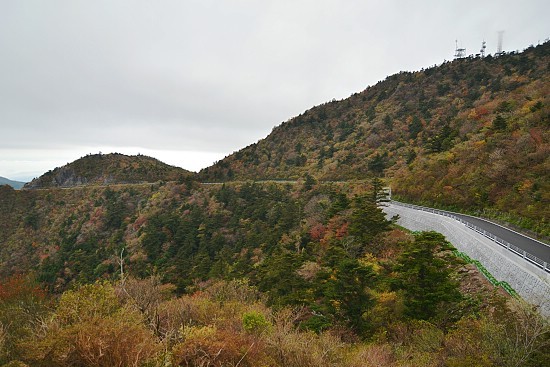Unzen Report
| Autumn Color Report 2011 Official autumn color reports by japan-guide.com |
| Guide to Autumn Colors - Schedule of upcoming reports - Post your own report |
| previous post |
| next post |
2011/11/12 - Unzen Report
by scott

Today we visited Mount Unzen in Nagasaki Prefecture for our first autumn color (koyo) report of the season from Kyushu, Japan's southern-most main island. Mount Unzen lies east of Nagasaki City, and is an active volcano that last erupted in the 1990's where it destroyed an entire village and killed several people.
The 1486 meter tall mountain's forested slopes change colors relatively early in the season, typically from late October through mid November. However this seems to have been an unusual year, and the autumn colors were relatively muted and not as vibrant as they are normally. Also, the season peaked slightly early, and the leaves are starting to be knocked down by the strong mountain wind and rain.


Mount Unzen is a great mountain to visit besides the autumn colors, though, and part of the draw is the hike up Fugendake Peak from where you can see Heisei Shinzan, the mountain's newest peak that was formed when the mountain last erupted. A winding toll road leads to Nitatoge Pass where there trail to the summit begins. The Unzen Ropeway leads up the mountain from a station at the pass, and bypasses almost half of the trail.




True to its name (Unzen means Cloud Hermit), the ropeway disappeared into thick clouds that clung to the mountaintop. Visibility was very poor, but we set out on the hiking trail that leads along the ridge from the upper ropeway station to Fugendake, hoping that the clouds would clear by the time we got there.



The trail wasn't very difficult or steep, but the swirling wind and fog kept us from any great views out over the slopes. Though we did occasionally get a small break in the mist when we could look around. After about an hour of hiking we reached the top of Fugendake, Mount Unzen's second tallest peak and the furthest that you can safely climb up the mountain. From there you can look out over at Heisei Shinzan peak, which looks like a large pile of volcanic stone.




We were able to take a few quick pictures of Heisei Shinzan, but the weather didn't hold and the summit was quickly re-enveloped in fog. Several more hikers arrived and we all waited and hoped for the fog to clear. But after a very cold, very windy 30 minutes we had to give up and head back down the mountain.



Of course, the weather begins to clear right after we leave, and there were beautiful cloudless blue skies around the mountain top just as we arrived back at the trailhead. Overall it was a very pleasant hike. It wasn't too steep, and only about 2 hours round trip.


A little ways down the mountain lies Unzen Onsen, a small hot spring town that has a very active hot spring field. These rocky areas, known as hells (jikoku), are littered with hot water springs that bubble straight up through the ground. Some of the hot spring water is captured and redirected to the ryokan baths in the town.
The hells lie along forested slopes that change colors during the autumn season and provide some nice contrast to the hot spring field's barren rock and billowing steam vents. The mountain bushes and trees around the hells are much like those found around the ropeway, and look like they may also have muted colors this year. However the koyo also seemed to be just around the peak, which is a little bit later than up at the ropeway since the elevation is lower here.


| previous post |
| next post |
|
List of Posts:
2011/12/13 - Tokyo Report 2011/12/08 - Kamakura Report 2011/12/05 - Tokyo Report 2011/12/02 - Kyoto Report 2011/12/01 - Nara Report 2011/11/30 - Kyoto Report 2011/10/27 - Nikko Report 2011/09/27 - Norikura Report |
Questions? Ask in our forum.